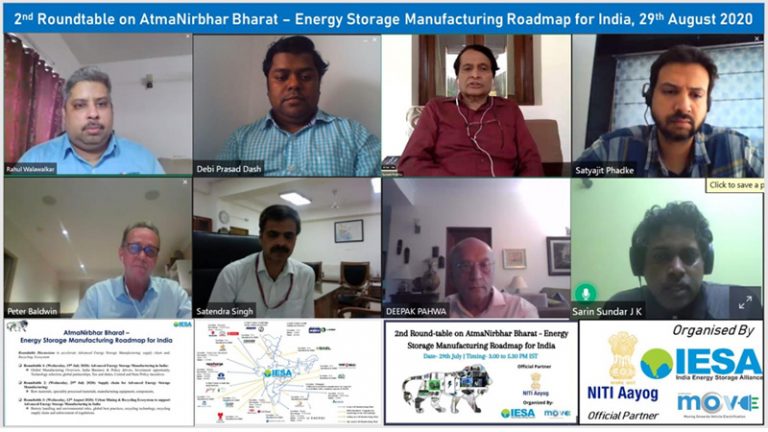IESA | July 29, 2020

India Energy Storage Alliance (IESA) concluded its 2nd roundtable virtual meet on AatmaNirbhar Bharat – Energy Storage Manufacturing Roadmap for India on a high note. Attended by over 100 key industry stakeholders, the roundtable was graced by some eminent dignitaries like Mr. Suresh Prabhu, India’s Sherpa to G20, G7, Member of Parliament, GoI; Mr. Satendra Singh, Joint Secretary, Ministry of Mines; Peter Baldwin, Commissioner India, Government of Western Australia; Mr. Deepak Pahwa, Managing Director, Bry-Air; Mr. Sarin Sundar Kuppuswamy, CTO office, Applied materials; Mr. Jasmeet Kalsi, Director, Manikaran Lithium; Dr. Rahul Walawalkar, President, IESA, and officially supported by India’s highest planning body the NITI Aayog.
The event was attended by 5+ country embassies from Japan, Netherland, Western Australia, USA, Norway, and central government officials from the Ministry of External Affairs, Ministry of Electronics and Information Technology, Ministry of Science & Technology, Ministry of Mines, NITI Aayog and 100+ industry stakeholders.
The roundtable discussed the key measures that will enable the future transition towards a green economy sustainably and also suggested ways towards enhancing the future energy storage bundled with accelerating technological innovation for environment-friendly processes.
Speaking at the roundtable, Mr. Suresh Prabhu, India’s Sherpa to G20, G7, MoP said: “Storage is the part of the human behavior. India is the second-highest consumer of energy in the world, and will gradually climb up to the top of the ladder. There is a need to work on a roadmap on energy storage. The concept of energy storage existed before but it only coming to fore now as the world, especially India focusses more on renewable power generation. There is an accelerating need for India to invest in R&D into innovation within the spectrum of energy storage in a big way. In this roundtable, we are focusing on AatmaNirbhar Bharat. How do we do that? It can be done by facilitating available resources to local developers on an optimal scale. Energy is an important aspect of AatmaNirbhar Bharat. This will only happen when a locally developed R&D system will come to the forefront.
I would like to congratulate India Energy Storage Alliance for providing this platform to discuss and deliberate on the roadmap to energy storage in India in a much-focused manner,” he added.
Mr. Satendar Singh, Joint Secretary, at the Ministry of Mines, Government of India said, “As the Ministry of Mines, we look for availability of minerals required in making batteries. As far as availability of lithium is concerned we are mainly looking at a few minerals bearing lithium. Geological Survey of India (GSI) is actively doing exploration work for these minerals. So far, there have been encouraging results from the state of Chhattisgarh, Bihar, and Rajasthan. The initial findings indicate that there could be possible lithium-bearing minerals [in these states]. In the Purulia district, West Bengal, they have found a deposit of pegmatite which has around 1.05% of lithium in it. They are further working on these findings and trying to locate all such areas to establish actual reserves and resources that we find in India.”
An MoU was signed between KABIL from India and JEMSE from Argentina for sourcing of Lithium and Cobalt. They are now working on mutual studies, sharing info, and looking at how to start the off-take of Lithium [exploration], he added.
Mr. Peter Baldwin Commissioner, India, Government of Western Australia said, “We have all the key minerals required for battery energy storage and other rare earth minerals. Therefore, we have a crucial role to be partnering with India.”
Mr. Deepak Pahwa, Chairman, Pahwa Group & Managing Director, Bry-Air (Asia) said, “Lithium-battery production rests on four pillars (enablers): technology, machinery, dry room, raw materials, and components. India today is 100% self-sufficient in this area [dry room]. While we are dependent on others for raw materials, machinery, and technology, India has the product and world-class technology for dry rooms. We are currently working with our German partners, as a solution provider for dry rooms, for a new plant that is coming up in Germany for Li-ion battery production. We are manufacturing the dry room equipment [dehumidifier] and supporting them with the flow of information for the production room, which will be done locally.”
In India, we have worked with BHEL, Amara Raja, DRDO, IIT Kharagpur and we are currently installing dry rooms for ISRO. We at [Bry-Air] are committed to supporting PM Modi’s AatmaNirbhar Bharat plans and are exploring different opportunities to be the part of the same,” he further added.
Mr. Jasmeet Singh Kalsi, Director, Manikaran said, “We may have started late but we have ample opportunity to catch up and develop the local industry for manufacturing. To develop [Li-ion] batteries, raw materials is the most important material and companies like ours [Manikaran Lithium] is trying to fulfill that need.”
Mr. Sarin Kuppuswamy, CTO, Applied Materials, India said, “High energy density is very important for all energy storage applications in EVs, drones, consumer electronics. What we plan is high energy density [batteries] moving in the future.
Besides, we are exploring opportunities to work with research partners, as the cell chemistries will vary depending on who wants to manufacture,” he added.
IESA’s 3rd Virtual roundtable on AtmaNirbhar Bharat – Energy Storage Manufacturing Roadmap for India will be held on 12th August 2020. It will focus on Urban Mining & Recycling Ecosystem to support Advanced Energy Storage Manufacturing in India (battery handling and environmental rules, global best practices, recycling technology, recycling supply chain and enforcement of regulations, second life, urban mining).




